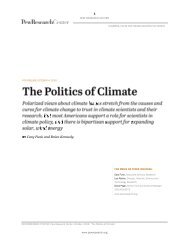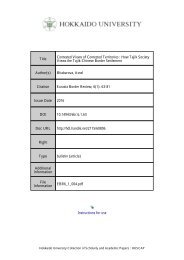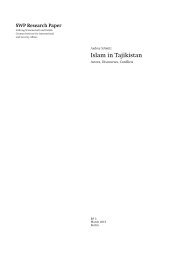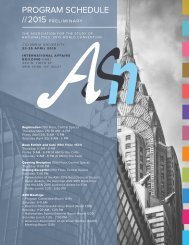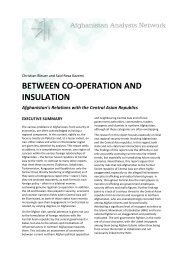Afghanistan in 2015 1
mM5Zmj
mM5Zmj
Create successful ePaper yourself
Turn your PDF publications into a flip-book with our unique Google optimized e-Paper software.
6<br />
<strong>Afghanistan</strong> <strong>in</strong> <strong>2015</strong><br />
recorded over the past 10 years, follow<strong>in</strong>g last year’s record high dur<strong>in</strong>g the presidential runoff<br />
election. Overall optimism has decreased across all regions, and is lowest <strong>in</strong> the Central/Kabul<br />
(27.8%) and North West (30.5%) regions. This year, Afghans <strong>in</strong> Helmand prov<strong>in</strong>ce (62.1%) are<br />
the most optimistic about the overall direction of the country, and residents of Kabul prov<strong>in</strong>ce<br />
(22.5%) are the least optimistic.<br />
• Reasons for optimism. Those who say the country is mov<strong>in</strong>g <strong>in</strong> the right direction cite reasons of<br />
reconstruction (31.8%), followed by good security (28.5%). The percentage of respondents cit<strong>in</strong>g<br />
good government (10.5%) has <strong>in</strong>creased four percentage po<strong>in</strong>ts s<strong>in</strong>ce 2014. Good security is most<br />
likely to be cited as a reason by Afghans <strong>in</strong> the Central/Hazarajat (39.9%), South West (33.7%),<br />
and East (29.9%) regions, while other regions are more likely to cite reconstruction as their top<br />
reason for optimism.<br />
• Reasons for pessimism. Among the 57.5% of Afghans who say their country is mov<strong>in</strong>g <strong>in</strong> the<br />
wrong direction, the most frequently cited reason is <strong>in</strong>security (44.6%, up six percentage po<strong>in</strong>ts<br />
from 2014), followed by unemployment (25.4%), corruption <strong>in</strong> general (13.0%), a bad economy<br />
(12.4%), and bad government (11.4%). The percentage cit<strong>in</strong>g bad government <strong>in</strong>creased from<br />
4.9% <strong>in</strong> 2014, while the percentage cit<strong>in</strong>g adm<strong>in</strong>istrative corruption decreased from 9.6% <strong>in</strong> 2014<br />
to 4.6% <strong>in</strong> <strong>2015</strong>.<br />
• <strong>Afghanistan</strong>’s biggest problems: national and local. The most frequently cited national problem is<br />
<strong>in</strong>security (42.7%), up from 34.1% <strong>in</strong> 2014 and at its highest level s<strong>in</strong>ce 2007. The most frequently<br />
cited local level problem is unemployment (31.2%). However, the percentage of Afghans cit<strong>in</strong>g<br />
<strong>in</strong>security as a local problem (22.0%) is at its highest level s<strong>in</strong>ce the survey began.<br />
• Biggest problems fac<strong>in</strong>g women. As <strong>in</strong> previous years, Afghans identify education and illiteracy<br />
(20.4%) and unemployment/lack of job opportunities (11.3%) as the two ma<strong>in</strong> problems fac<strong>in</strong>g<br />
women. However, the frequency with which they have been cited has decl<strong>in</strong>ed s<strong>in</strong>ce 2014, while<br />
the percentage of Afghans who cite a lack of women’s rights has <strong>in</strong>creased from 6.2% <strong>in</strong> 2014 to<br />
8.7% <strong>in</strong> <strong>2015</strong>. In general, men and women po<strong>in</strong>t to the same challenges fac<strong>in</strong>g Afghan women,<br />
with the exception of the issue of domestic violence, which is more often mentioned by women<br />
(13.0%) than men (8.1%).<br />
• Biggest problems fac<strong>in</strong>g youth. In all <strong>in</strong>dividual prov<strong>in</strong>ces and also at the national level,<br />
unemployment (71.4%) is the most commonly cited problem fac<strong>in</strong>g youth. At the national<br />
level, this is followed by illiteracy (26.5%), a poor economy (15.9%), lack of higher education<br />
opportunities (15.3%), and drug addiction (14.2%). Afghans who live <strong>in</strong> the Central/Kabul<br />
(23.5%) and North East (20.2%) regions are more likely to cite the need for opportunities <strong>in</strong><br />
higher education, while residents of the East (36.9%) and South West (33.3%) regions cite the<br />
more basic challenge of illiteracy.<br />
• Self-reported happ<strong>in</strong>ess. Despite a major drop <strong>in</strong> national optimism about the direction of the<br />
country s<strong>in</strong>ce 2014, Afghans report general happ<strong>in</strong>ess at roughly the same rate <strong>in</strong> <strong>2015</strong> as <strong>in</strong> 2014.



